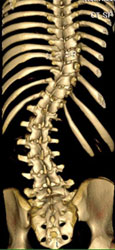
Scoliosis treatment Singapore
Overview of Scoliosis
Scoliosis in patients between 10 and 18 years of age is termed adolescent scoliosis and can be due to many causes.
By far the most common type of scoliosis in the adolescent period is one in which the cause is not known and is called idiopathic or adolescent idiopathic scoliosis (AIS).
Although significant ongoing research continues in this area, including the genetic basis for AIS, there are no identifiable causes for this condition today.

scoliosis treatment singapore
Causes
There are significant efforts being made toward identifying the cause of AIS, but to date there are no well accepted causes for this particular type of scoliosis.
The vast majority of patients are otherwise healthy and have no previous medical history.
Physical Findings
There are many visible symptoms associated with adolescent idiopathic scoliosis.
Depending on the curve pattern and the size or magnitude of the curve, scoliosis may be barely seen or it may have significant visible symptoms.

Scoliosis treatment Singapore
Treatment
Treatment of adolescent idiopathic scoliosis falls into three main categories (observation, bracing and surgery), and is based on the risk of curve progression.
In general, AIS curves progress in two ways:
1. During the rapid growth period of the patient.
2. Into adulthood if the curves are relatively large.
Practicing Yoga With Scoliosis
If you have scoliosis, it’s important to check with a medical professional before embarking on a yoga practice.
During your consultation, the more information you can find out about your curve pattern the better.
Work with your doctor, physical therapist, or chiropractor to find out which adjustments bring your torso closer to neutral—i.e., what you have to do, and in what order, to even out your hips, shoulders, and head.
You can then apply this information to your yoga practice.
Scoliosis Do’s
1. Do asymmetrical poses a second time on the more challenging side…or stay on that side longer.
2. Using mirrors, practice self-study to create a longer, more neutral spine.
3. Strengthen core- and back-stabilizing muscles by holding neutral in increasingly challenging positions.
4. Practice pranayama.
5. Emphasize poses that lengthen the muscles between the ribs, like side bends and side glides.
6. Practice slowly, holding each pose for at least five breaths.
7. Add yin or restorative classes to your yoga regimen.
8. Take a side-lying savasana.
Scoliosis Don’ts
1. Don’t practice inversions without support if your scoliosis is severe or you are experiencing pain.
2. Don’t expect asymmetrical poses to look (or feel) exactly the same on both sides.
3. Don’t become overly stressed by the degree of your curvature as you practice, or how much or little your yoga practice is changing your curvature.
Workhealthplace has Yoga classes for Scoliosis treatment Singapore
Our yoga for scoliosis focus on trigger point release, alignment, building up awareness, stretching and strengthening, de-rotation if there are any.
It can be done with a small group or private 1-1 class.
Check our More Scoliosis treatment Singapore programs @ Health Programs
Also there are much more at https://workplacehealth.sg
Workplacehealth bring yoga, dance & fitness classes to the companies and encourage employees to stay healthy.
On top of that, we also organize health talks and other mental health programs to help employees to stay fit.
Stay healthy not only physically but also mentally.For more such blog posts, stay tuned! Also, don’t forget to follow us on Facebook and Instagram.










